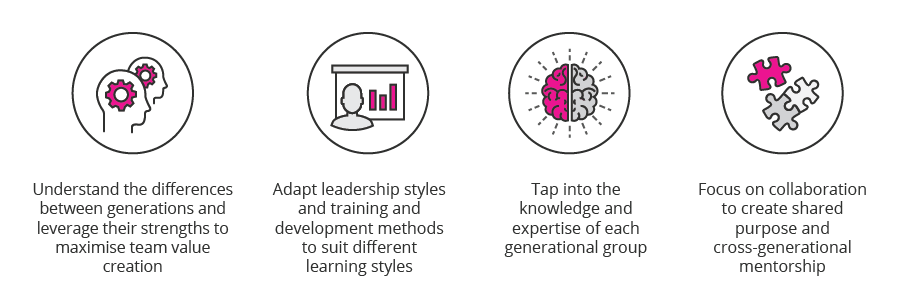How to lead and manage a multigenerational workforce
As society, technology and social paradigms evolve, so too do workplace interactions and composition. Learning to manage, motivate and communicate with an increasingly age-diverse workforce is a growing concern for business leaders and managers.¹
Gone are the days of paying one’s dues and rising through the ranks. As technology has become more disruptive, the workplace has become more multigenerational. This presents a challenge to leaders and HR professionals alike.

Learn to lead and manage people efficiently, taking age into account, with this helpful list of do’s and don’ts.
Traditionally, business leaders, marketers and HR professionals have split generations into several groups, defined by their year of birth. These include: Traditionalists, Baby Boomers, Gen X, Millennials and Gen 2020.
Meet the different generations:
TRADITIONALISTS (pre-1946):
When managing Traditionalists, remember that these individuals value authority, tradition and shared purpose. As such, they’re loyal employees with a strong work ethic. They grew up in a tough economic situation, followed by prosperity.
Do:
- Respect their viewpoint when managing change or ambiguity
- Offer subtle, personal recognition
- Create a consistent work environment by establishing processes
Don’t:
- Disrespect organisational hierarchy
- Allow for uncertainty when communicating goals
- Miss a leadership opportunity to leverage their experience and facilitate mentorship
BABY BOOMERS (1946-1964):
Baby Boomers are highly driven employees that value teamwork, personal rights and personal growth above all else. They’re most likely to work overtime, but offer different leadership challenges and opportunities.
Do:
- Provide purpose by communicating corporate and leadership goals
- Offer opportunities for project leadership and ownership
- Foster growth through effective human resource management techniques
Don’t:
- Disregard attempts to challenge the status quo
- Allow good work to go unrecognised and unrewarded
- Fail to align personal growth strategies with business targets
GEN X (1965-1976):
Children of divorce, Gen X employees value independence, work-life balance and education. They’re classified as highly educated, entrepreneurial spirits who believe in working smarter, not harder, and therefore present difficulties to business leaders.
Do:
- Create a casual, yet engaging work environment
- Encourage the pursual of interests outside of work
- Reward work with time off or remote working
Don’t:
- Enforce a strict work schedule
- Micromanage
- Fail to address disengagement or under-stimulation
MILLENNIALS (1977-1997):
Millennials grew up in the digital age. They’re tenacious and ambitious workers with short attention spans. This can be taxing or hugely beneficial for those in leadership and people management roles. Idealism, fun and competition rank top of the millennial list of values.
Do:
- Challenge them with diverse work to develop transferable skills
- Surround them with creative, future-oriented thinkers and leaders
- Encourage continued studies and CSR involvement
Don’t:
- Enforce any form of structure or hierarchy
- Hesitate to encourage project leadership
- Fail to implement time-off or flexi-hour work incentives
GEN 2020 (post-1997):
Gen 2020 employees have been online since birth. They’re the most socially aware generation, and value collaboration and meaningful impact above all else. Employee engagement and authentic leadership are most valuable to HR managers dealing with this Gen 2020s, as they are more cautious in their careers and have low levels of organisational loyalty.
Do:
- Involve them in complex, meaningful problem solving
- Incentivise them with tools to turn their ideas into action
- Avoid conflict and confrontation
Don’t:
- Engage them in over 20% of menial work, they need to be cognitively stimulated 80% of the time
- Impose decision-making responsibilities on them
- Neglect their opinion
Armed with the knowledge of how to incentivise and engage multigenerational employees, leaders are empowered to take their organisations to new heights. However, knowledge is only half the battle.
Knowledge is power, and with power comes responsibility. Business leaders and HR managers need to use this information to improve workforce morale, productivity and wellbeing. Use these four reminders to be a better leader:

Whatever generation you’re in, an up-to-date skill set will help you stand out.
Browse over 60 online short courses from the world’s leading universities.
¹Source: futurehrtrends.eiu.com